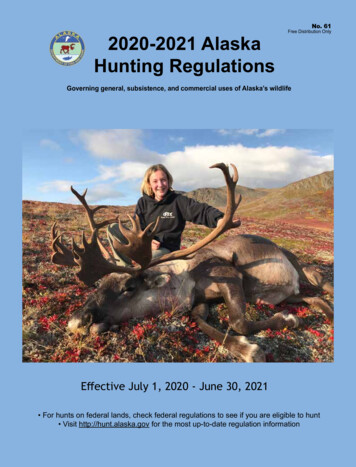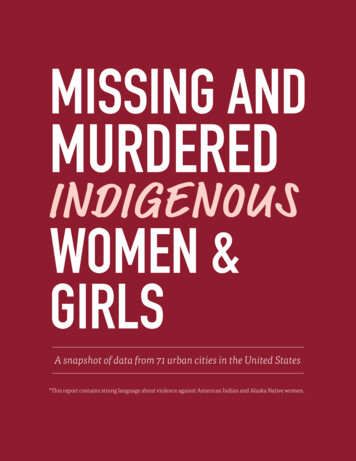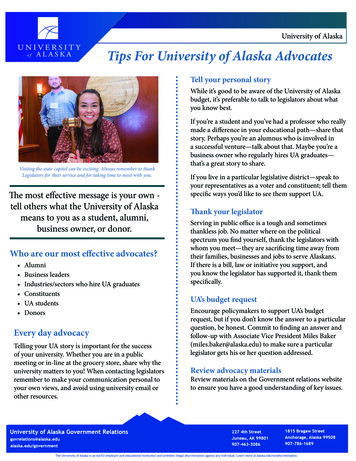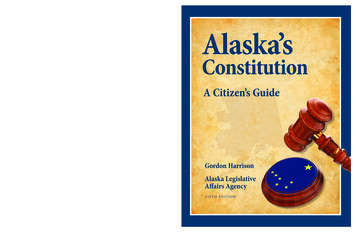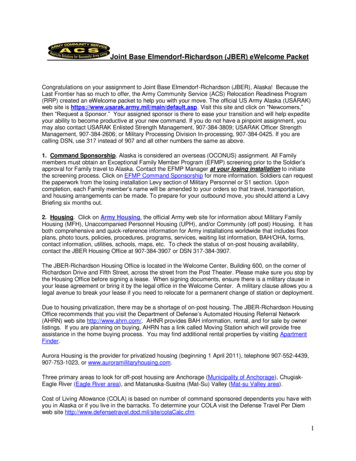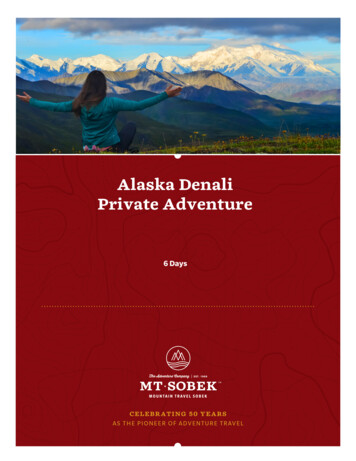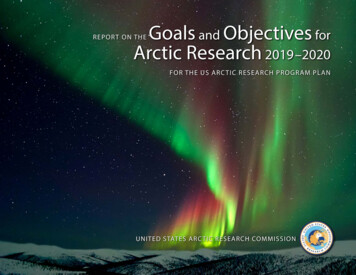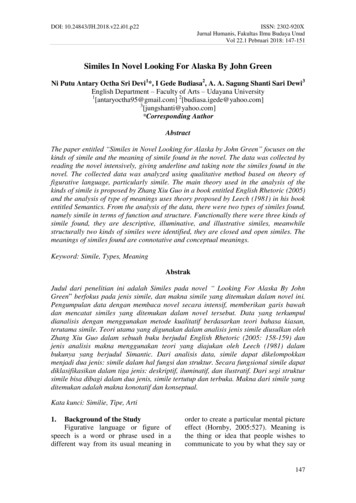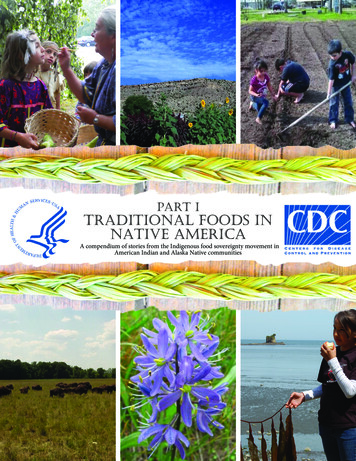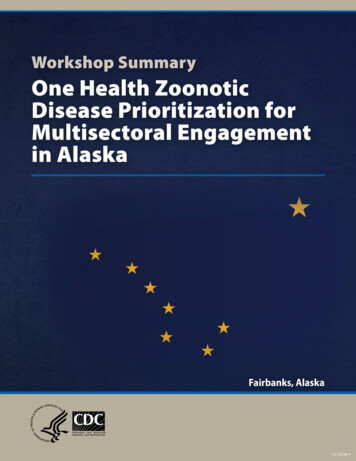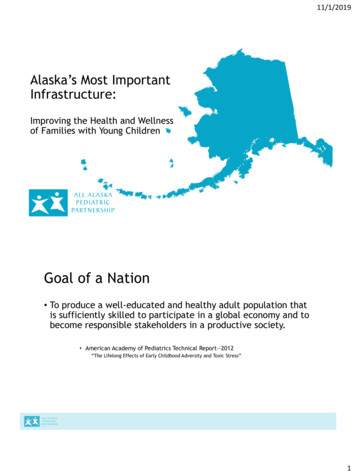
Transcription
11/1/2019Alaska’s Most ImportantInfrastructure:Improving the Health and Wellnessof Families with Young ChildrenGoal of a Nation To produce a well-educated and healthy adult population thatis sufficiently skilled to participate in a global economy and tobecome responsible stakeholders in a productive society. American Academy of Pediatrics Technical Report—2012“The Lifelong Effects of Early Childhood Adversity and Toxic Stress”1
11/1/2019How Do We Do That Use good science to make good investments Need to invest in evidence-based practices that address complexsocial, economic, environmental, and developmental issues thatinfluence population-based health disparitiesImpact of NeglectBruce Perry, MD2
11/1/2019Critical Concepts in Early BrainDevelopment Brain growth andplasticity Critical periods ofsequential development Molecules in the brain thatstimulate neural plasticity Role of experienceSynapses Connections The human brain is shaped through neuronalconnections Changes in these connections birth: 50 trillion synapses 1 year: 1,000 trillion 20 years: 500 trillion The remodeled brain facilitates efficiency andlearning3
11/1/2019Synaptic Growth and Pruning Synaptic pruning occurs in areas that are infrequently used Results in decreased number of synapses between neurons Maximum number of synapses occurs around age 3 y/o Allows for improved functionality and efficiency of synaptictransmission in the brain Plasticity (the ability to change your brain) essentially reachesadult levels by age 10 y/oBrain Development as a Measure ofSynapse Formation4
11/1/2019Physiologic Response to Stressin Kids Stress without the buffering response of a strong adultrelationship causes prolonged, brain-controlled secretion ofstress hormones Cortisol, norepinephrine, epinephrine, etc. Stress responses are beneficial in the short term with adultsupport, but can be damaging to health if they occur over longperiods of time Constant wear and tear Potentially permanent changes in gene regulation5
11/1/2019EpigeneticsEpigenetics in Rats Rat mothers who groom and lick their pups during the firstweek of life have pups that have a less vigorous response tostress as adults than mothers who don’t groom well Appears to be caused by DNA methylation and histone changes in stress-relatedgenes Stressed rat mothers with bad nurturing behavior have pupswith poor cognitive skills as adults and persistent changes instress-related gene expression6
11/1/2019Childhood Epigenetic Changes Kids raised in institutional environments (Romanianorphanages) Epigenetic changes in regions of brain development Adults exposed to abuse as kids: 997 different genes had methylation patterns that were differentthan from adults who were not abused Genes were involved with cell signaling pathways, brain development, immunefunction, stress regulation, etc Similar results from adults from the foster care system, adultsexposed to violence as kids, adults exposed to neglect as kids How Do These Epigenetic Changes AffectStressed Kids Structural brain changes: Smaller hippocampus (memory),smaller corpus callosum (connections between thehemispheres of the brain), smaller prefrontal cortex(reasoning, emotional control), larger amygdala (anxiety andrelease of stress hormones from the pituitary) Inflammation/immunological changes: C-reactive protein,stress cytokine levels elevated in adults with history of earlyadversities Endocrine changes: Dysregulation of stress hormones,decreased oxytocin7
11/1/2019Epigenetics Passed from Moms toChildren Fetal exposure to maternal stress influences future stressresponses in a negative way through epigenetics Moms who are stressed (stressful event—famine, increased anxiety,depression) during pregnancy are more likely to have kids with: Preterm birthPoor emotional coping skillsDecreased cognitive abilitiesIncreased fear response to stimuliIncreased anxietyDecreased immune functionAutismLots of others .Epigenetics Passed from Dads to Sons Offspring of Civil War prisoners (4600 kids) Sons—died earlier Sons born before the war didn’t have any mortality differences Daughters—unaffected Seems to occur through transmitted RNA molecules rather thanmethylation or histone modification8
11/1/2019Telomeres and Stress Telomeres appear tobe impacted bytrauma in childhood Adults exposed totrauma as a child hadshortened telomeres Marker of acceleratedageing and diseaseBut These Epigenetic Effects Can BeReversed Prevention programs that result in improved family functionand better parenting skills result in: Reversal of epigenetic changes in young children Reverses the brain changes seen in adulthood Improved health outcomes Decreased mental health issues Decreased costs9
11/1/2019Public Investment in Children by AgePublic Investment in Children by BrainGrowth10
11/1/2019Econometrics of EarlyIntervention & Prevention Funding early interventionsprovides the largest possiblereturn on investmentDoyle et al. (2009) Investing in Early HumanDevelopment. In: Economics and Human Biologyv7:pp1-6Costs of Child Abuse: USA Over 124 billion in costs/year (Fang et al., 2012) Lifetime cost per victim of nonfatal child maltreatment is 210,012:- 144,360 productivity losses- 6,747 criminal justice costs- 32,648 childhood health care costs- 10,530 adult medical costs- 7,999 special education costs- 7,728 child welfare costs11
11/1/2019A Common Language to Explain Development10 adverse childhood experiences surveyed:1.2.3.4.5.Physical abuseSexual abuseEmotional abuseEmotional neglectPhysical neglect--------6. Witness domestic violence7. Mental illness in home8. Family member incarcerated9. Alcohol/drug problems10. Parental separation or divorceACEs: Prevalence data Prevalence of ACEs in study group: Sexual abuse 21%Domestic violence in childhood home 13%Substance abuse in home 28%Parental separation or divorce 24%Physical abuse 28%Emotional neglect 15%Emotional abuse 11%Physical neglect 10%Mental illness in home 20%Criminal household member 5%M Dong et al. (2003) Child Abuse and Neglect v27, pp 625-639.12
11/1/2019ACEs: Adult Health Key finding: About 2/3rd of those surveyed reported at least one ACE. The 1/3 of participants with no reported ACEs were consistentlyhealthier across all measures.ACEs Score Dose ResponseRisk of Poor Health0.70.60.50.40.30.20.1012345 6Aces Score13
11/1/2019Health Measures Now Linked toAdverse Childhood Experiences Score Stepwise increased risk for: Heart diseaseAsthmaDiabetesCancerCOPDSkeletal fracturesSexually transmitted diseasesLiver diseaseAutoimmune disordersOsteoarthritisSmokingAlcohol abuseOver eating and obesityIllicit drug usePromiscuityIV drug useClinical depression And Autobiographical memory disturbancePoor anger controlRelationship problemsEmployment problemsEarly age at first intercourseTeen pregnancyUnintended pregnancyTeen paternityFetal deathSuicideDomestic violenceAnxiety disordersHallucinationsSleep disturbancesChronic painHeadachesEarly deathACEs: Alaska vs. 10 States14
11/1/2019Alaska ACEs inChildren Alaska Children and YouthACEs in the GeneralPopulationAlaska ACEs inChildren Alaskan Children and YouthACEs for those whoExperienced Low Income15
11/1/2019Disparities in Vocabulary DevelopmentAlaska ACES inChildren Alaskan Children and YouthACEs for those who WitnessDomestic Violence16
11/1/2019Intimate Partner Violence andChild Maltreatment 8.4% of Alaska moms report some form of intimate partnerviolence during the 12 months prior to or during pregnancy 60% of children born to these moms experienced a report to OCS And .intimate partner violence was present in 19.6% ofchildren who had an OCS reportJared Parish—State of AlaskaMaternal Stress andOCS Referrals Before 7 y/o, half of allchildren born to moms with 4or more stressors arereported for childmaltreatmentStressors:1. Being homeless2. Husband/partner went to jail3. Being in a fight4. Loss of job even though wanted to keep working5. Husband/partner lost job6. Argued with husband/partner more than usual7. Close family member very sick or hospitalized8. Separated/divorced9. Moved to a new address10. Husband/partner said they didn’t want pregnancy11. Has a lot of bills couldn’t pay12. Someone close had problem with drinking/drugs13. Someone close diedJared Parish—State of Alaska17
11/1/2019Age When US Kids Accumulate Half ofTheir Lifetime ACEsCostsAlaskan adults who report four or moreACEs compared to Alaskan adults whoreport zero ACEs. 49% more likely to be unemployed 274% more likely to be unable to work 92% more likely to earn less than 20,000 annuallySource: 2013 Alaska Behavioral Risk Factor Surveillance System, Analysis by Alaska MentalHealth Board/Advisory Board on Alcoholism and Drug Abuse Staff18
11/1/2019Population Attributable Risks in AlaskaSource: Alaska data from the 2013 Alaska Behavioral Risk Factor Surveillance System, Alaska Department of Health and Social Services,Division of Public Health, Section of Chronic Disease Prevention and Health Promotion, Graphic: AMHB/ABADAAlaskan ACEs Compared to Two Other 5%0%ZeroOneTwo-ThreeFour PlusACE ents/2010 data brief 5949a1.htm19
11/1/2019Alaskan ACEs with a One Half ACE Reduction Compared to TwoOther rmont25%20%21%23%19%15%18%21%21%AK 1/214%10%13%14%5%0%ZeroOneTwo-ThreeFour PlusACE ents/2010 data brief 5949a1.htmReducing Alaska’s ACE Score by ½ Point If we just look at the reduction of ObesityAdult Medicaid recipientsSmokingBinge drinkingDiabetesArthritis Alaska will save 90 million annually20
11/1/2019What Does 90 Million Buy in Alaska? 258 three bedroom homes in Anchorage (average price 347,000) 915 kindergarten teachers (wages only 66,384 40%) 97,938 846 police officers (wages only 75,672 40%) 105,941 518 mechanical engineers (wages only 123,600 40%) 173,040 339 pediatricians (wages only 189,000 40%) 264,600 Office of Children’s Services - General Funds 2016 – Operations All of the Behavioral Health State Medicaid Costs 18 million The General Funds for the Department of Commerce, Community & Economic Development The Department of Labor & Workforce Development 103,307 Flights from Ketchikan to Barrow in July ( 868) Boeing 737-800 17 million for fuel and crew.Pick cfm#LIf Alaska Had ACE Rates Similar to Arkansas and Vermont the Estimated Reduction inNumber of Alaskan Adults for Each Categoryof Economic and Educational Outcome80006,718Number of Alaskan n'tGraduatedCollegeCouldn't AffordDoctor6.0%0Doesn't OwnHomeMakes Less then Unemployed 20,000Unable to work Less Than HighSchool DiplomaOutstandingMedical BillEconomic and Educational CategoryCalculations based on 2013 Alaska BRFSS data conducted be the Alaska Mental Health Board and Advisory Board onAlcoholism and Drug Abuse Staff21
11/1/2019If Alaska Had ACE Rates Similar to Arkansas and Vermont the Estimated Reduction inNumber of Alaskan Adults for Each Categoryof Behavioral Health Outcome100009,3759000Number of 410003.7%2.8%10.4%10.7%0Heavy drinkingDepressionInsufficient SleepFrequent mental DistressBehavioral HealthCalculations based on 2013 Alaska BRFSS data conducted be the Alaska Mental Health Board and Advisory Board onAlcoholism and Drug Abuse StaffIf Alaska Had ACE Rates Similar to Arkansas and Vermont the Estimated Reduction inNumber of Alaskan Adults for Each Category ofFood Insecurity OutcomeNumber of Alaskan 00011.6%8.9%7.0%7.0%0Cut the Size of, or SkippedMeals Because Couldn't GetFoodWere Hungry & Did Not EatBecause No FoodUsed Community Food BankUsed Government FoodProgramFood Insecurity MeasureCalculations based on 2013 Alaska BRFSS data conducted be the Alaska Mental Health Board and Advisory Board onAlcoholism and Drug Abuse Staff22
11/1/2019How Do We Identify TheseKids?What We’re Really Talking About Is TraumaInformed Care This means we ask the question, “Let’s have a conversation .” ratherthan “What’s wrong with you?” This fundamentally changes the way we interact with people Changes a interaction with a family from “I must fix you” to “I will listen to you”23
11/1/2019Behaviors Associated withEarly Childhood Trauma Ages: 0-2 Dysregulated eating,sleepingpatterns Developmental regression Irritability, sadness, anger Poor appetite, low weight gain Increased separation anxiety,clinginess https://www.ecmhc.org/tutorials/trauma/mod3 1.html -treating-childtraumatic-stress Ages 3-6 Increased aggressionSomatic symptomsSleep difficulties/nightmaresIncreased separation anxietyNew fearsIncreased distractibility/highactivity levelIncreased withdrawal/apathyDevelopmental regressionRepetitive talk/play about theeventIntrusive thoughts, memoriesAbsenteeismParent ScreeningQuestionaire One-page questionnaire,completed by the parent Targets risk factors thatjeopardize children’s health,development and safety Administered at selected wellchild visits Free, available in 4 languages ionnaire-24
11/1/2019Survey of Well-Beingof Young Children Comprehensive screeninginstrument for children under 5.Forms available for eachrecommended well-child visitrecommended by the AAP. Targets developmentalmilestones, social-emotionaldevelopment, and family riskfactors. Free; available in 3 languages theswyc.orgCenter for YouthWellnessACE-Q Available for young kids andteens25
11/1/2019Four Questions—Gets Almost Everything Has anything really stressful happened to your child since thelast time I saw you? How has that affected your child’s behavior? Corollary question: How has this event and any changes in yourchild’s behavior affected you? What have you done that’s really fun with your child since thelast time I saw you? Give me three words that describe your child to youOk .so screening ispositive.26
11/1/2019Just Screening is Pretty Effective Studies suggest that screening alone for ACEs can improvehealth and reduce both ER (11%) and sick office visits (31%) Just talking about past experiences with a respected provider relievesstress and improves physical and mental health Suggests that screening should start immediately, but .providersare nervousIf a Traumatic Stressor Is Identified: Assess for child and family safety Provide education/guidance about behavior management,routines and daily living activities to promote recovery andsense of safety Refer to social work, child protection, domestic violenceteam, etc, if needed Behavioral health/social work embedded into all clinics Alaska Child Trauma Center Help Me Grow Alaska27
11/1/2019Resilience to ACEs The most importantprotective resource toenable a child to cope withexposure to violence is astrong relationship with acompetent, caring, positiveadult, often a parent—butdoesn’t have to be!Resilience—Ordinary Magic With the support of goodparenting by either a parentor other significant adult, achild’s cognitive and socialdevelopment can proceedpositively even withadversity28
11/1/2019So .Where Is the Best Place toFocus Society Efforts toImprove Family Health Data from the National Survey onChildren’s Health (2011-12) combiningACEs data with chronic child healthoutcomes, and overlaying environmentalchanges to see if there is an effectEffect of Neighborhood Amenities onChild Health1.2.3.4.SidewalksParksRecreational CenterLibrary29
11/1/2019Effect of Neighborhood Amenities onChild HealthEffect of Neighborhood Detracting Elements onChild Health1. Litter or garbage about2. Dilapidated housing3. Broken windows or graffiti30
11/1/2019Effect of Neighborhood Detracting Elements onChild HealthEffect of Neighborhood Cohesion onChild Health1.2.3.4.People help each other outPeople watch each others childrenPeople to count onAdults I can trust31
11/1/2019Effect of Neighborhood Cohesion onChild HealthEffect of Self-Regulation Skills onChild Health1. Finishes tasks and follows through on commitments2. Stays calm and in-control when facing a challenge3. Shows interest and curiosity in learning new things32
11/1/2019Effect of Self-Regulation Skills onChild HealthKeys to Resiliency Providing supportive adult-child relationships Scaffolding learning so the child builds a sense of self-efficacyand control Helping strengthen adaptive skills and self-regulatorycapacities Using faith and cultural traditions as a foundation for hope andstability33
11/1/2019Self-Regulation:ARC Framework Attachment Caregiver affect management Attunement Consistent response Regulation Identification Modulation Expression Competency Executive function Self development Alaska Child Trauma Center—trainingavailable for organizations to implementARC Families 5 Protective Factors Parental Resilience Social Connections Knowledge of Parenting and ChildDevelopment Concrete Support in Times ofNeed Social-Emotional Competence ilies/Toolkit.pdf34
11/1/2019Foundations ofHealthy Development Healthy relationships Consistent Nurturing Protective Healthy environment Free from toxins Safe and active exploration Healthy nutrition Breastfeeding support Maternal nutrition** Traditional dietAPIA Head Start35
11/1/2019Building an Agenda for Families Universal screening for Social Determinants of Health to identify familiesat risk inants%20of%20Health%20Policy%20Digital.pdf Support systems of Primary Care and Behavioral Health Medicaid Alaska 1115 Waiver Child care and early education Universal, high-quality child care Alaska SB 6 Family economic stability Employment support for parents Paid parental leave Flexible work hours to attend school activitiesBuilding an Agenda for Families Support food security for families The Children’s Lunchbox Food Bank of Alaska Support programs that train caregivers and parents to care for their children Strengthening Families and Parenting Programs Support affordable, high-quality childcare for all families so that parents maywork without compromising their child’s development Thread Support the development of trauma-informed schools Transforming Schools: A Framework for Trauma Informed Practice in Alaska Juneau Trauma-Informed Schools Pilot Project Support a safe place for kids to go after school Campfire Alaska36
11/1/2019Building an Agenda for Families Community development Housing Environmental protection Support improved mental health services for families in all areas ofAlaska Judge Vanessa White’s Family Court in Palmer Alaska Child Trauma Center Support safe housing for families Support a living wage and ongoing training for teachers, Head Startworkers, and childcare workers In general . Intensive intervention and support for families at high risk of experiencing toxicstress!!!Basically .Families with young children areTHE infrastructure of Alaska, andthere’s nothing more important toAlaska’s successful future37
11/1/2019Finally . I didn’t grow up having rolemodels, I grew up havingpeople I didn’t want to belike and seeing situations I’dnever want to be in. Not allof us are dealt the rightcards, but that doesn’tmean you can reshuffle yourdeck for a better outcome.Thank you!!!Matthew Hirschfeld MD/PhDBoard ChairAll Alaska Pediatric Partnershipmhirschfeld@scf.ccwww.a2p2.org38
60% of children born to these moms experienced a report to OCS And .intimate partner violence was present in 19.6% of children who had an OCS report Jared Parish—State of Alaska Maternal Stress and OCS Referrals Before 7 y/o, half of all children born to moms with 4 or more st
